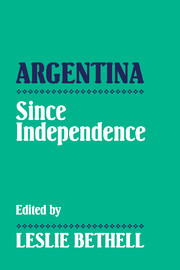Book contents
- Frontmatter
- Contents
- List of maps
- Preface
- 1 From independence to national organization
- 2 The growth of the Argentine economy, c. 1870–1914
- 3 Society and politics, 1880–1916
- 4 Argentina in 1914: The pampas, the interior, Buenos Aires
- 5 From the First World War to 1930
- 6 Argentina, 1930–1946
- 7 Argentina since 1946
- Bibliographical essays
- Index
5 - From the First World War to 1930
Published online by Cambridge University Press: 09 November 2009
- Frontmatter
- Contents
- List of maps
- Preface
- 1 From independence to national organization
- 2 The growth of the Argentine economy, c. 1870–1914
- 3 Society and politics, 1880–1916
- 4 Argentina in 1914: The pampas, the interior, Buenos Aires
- 5 From the First World War to 1930
- 6 Argentina, 1930–1946
- 7 Argentina since 1946
- Bibliographical essays
- Index
Summary
THE WAR AND POSTWAR ECONOMY
The decade and a half from the outbreak of the first world war to the onset of the world depression witnessed overall a continuation of Argentina's prewar economic prosperity based on the growth of its export sector. In 1929 Argentina was still the world's largest exporter of chilled beef, maize, linseed and oats, and the third largest exporter of wheat and flour. Comparing annual averages for 1910–14 with 1925–9, exports of wheat increased from 2.1 million tons to 4.2 million, maize from 3.1 to 3.5 million, and linseed from 680,000 to 1.6 million. Exports of chilled beef, which averaged only 25,000 tons between 1910 and 1914, increased to more than 400,000 between 1925 and 1929. Exports as a whole, which were valued on average at 4,480 million paper pesos at 1950 prices in 1910–14, increased to 7,914 million between 1925 and 1929. Per capita income in Argentina still compared favourably with most of Western Europe. Standards of living had risen, while illiteracy rates had again fallen. A substantial part of the population basked in prosperity and well-being. By 1930 there were 435,000 automobiles throughout Argentina, a substantially larger number than in many Western European countries, and a sevenfold increase from eight years before. Assisted once more by immigration, population rose by almost 4 million between 1914 and 1930, from 7.9 million to 11.6 million. In one sector, domestic oil, there was spectacular growth.
- Type
- Chapter
- Information
- Argentina since Independence , pp. 139 - 172Publisher: Cambridge University PressPrint publication year: 1993



